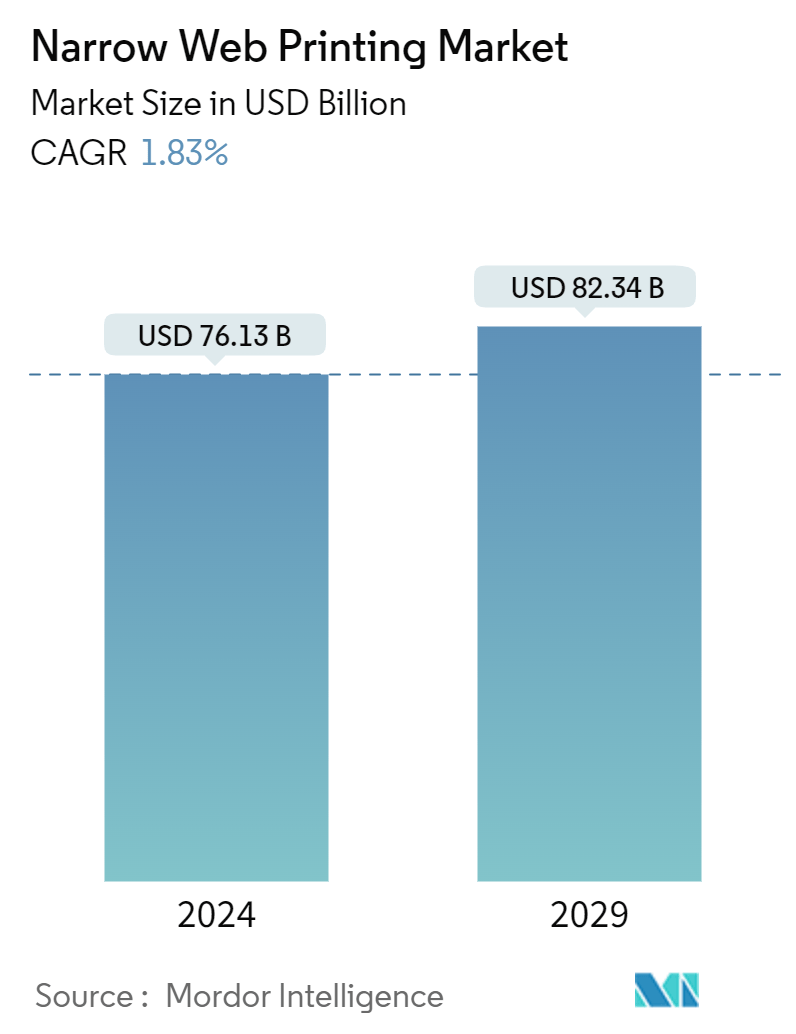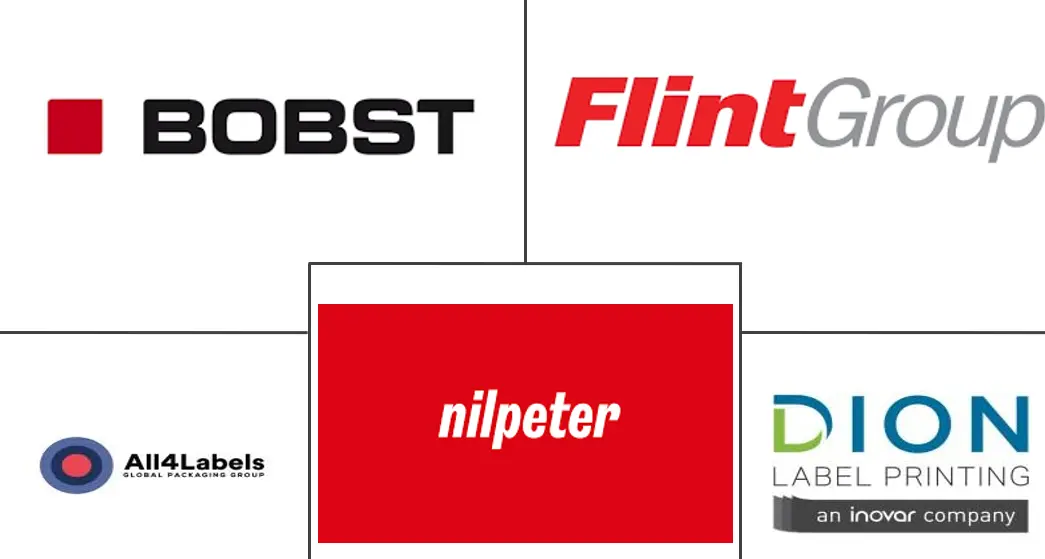Market Size of Narrow Web Printing Industry

| Study Period | 2019 - 2029 |
| Market Size (2024) | USD 76.13 Billion |
| Market Size (2029) | USD 82.34 Billion |
| CAGR (2024 - 2029) | 1.83 % |
| Fastest Growing Market | Asia Pacific |
| Market Concentration | Low |
Major Players
*Disclaimer: Major Players sorted in no particular order |
Narrow Web Printing Market Analysis
The Narrow Web Printing Market size is estimated at USD 76.13 billion in 2024, and is expected to reach USD 82.34 billion by 2029, growing at a CAGR of 1.83% during the forecast period (2024-2029).
Narrow web printing, a sub-part of flexographic printing, is known for its versatility and productivity. It is particularly suited for small to medium-sized companies. It employs a distinctive rotary and in-line conversion method, perfect for enterprises managing minor, personalized printing requests.
- In today's dynamic market, narrow web printing exemplifies the impact of specialized, efficient printing solutions. Its features, including high-speed production for short runs, flexibility, and top-tier quality, make it indispensable for companies aiming to elevate their packaging and labels.
- The rising demand for labels and packaging, especially in e-commerce, food, and beverage sectors, is the primary driver of growth of the narrow web flexo press market. Automation and the shift toward environmentally friendly ink choices are pivotal advancements shaping the market's landscape.
- In the pharmaceutical sector, narrow web printing excels in handling small formats. Its appeal extends to the alcohol industry, where it is increasingly favored for its ability to emboss or deboss wine labels and craft beer bottles, meeting client specifications. These finishing touches, like embossing and debossing, are seamlessly integrated into the narrow web label printing process.
- Businesses increasingly prioritize environmental concerns and global advocacy by adopting measures to reduce waste, notably by adopting eco-friendly packaging. Narrow web printing empowers companies to embrace sustainability using eco-consciousness. It uses UV-based inks due to their low emissions of volatile organic compounds (VOCs), which comply with environmental regulations. These UV-curable inks dry quickly and underscore narrow web printing's pivot toward sustainability, cutting waste and lessening its environmental footprint.
- However, manufacturing custom plates and setting them up can pose a significant cost barrier for very small production runs. Further, this printing technology is not very useful for companies running large production volumes. Although the narrow web is efficient and cuts down printing time, alternative printing like wide web is a more cost-effective choice for large-volume production.
- The versatility of narrow web flexo printing in handling diverse substrates expands its market potential. Technological advancements have notably enhanced prints' quality and consistency, bridging the historical gap with conventional methods like gravure and offset printing.
Narrow Web Printing Industry Segmentation
A narrow web printing press is primarily a flexographic press for narrow-width printing applications, typically prevalent in label and packaging production. Based on current trends and market dynamics, the study tracks and analyzes the demand for narrow web printing within the food, beverage, personal care and cosmetic, pharmaceutical, healthcare, and other industries. The market numbers are derived by tracking the revenue generated by players' narrow web printing equipment across the end-user industries.
The narrow web printing market is segmented by product type (labels [pressure sensitive & glue-applied labels, shrink sleeve labels, in-mold labels, thermal transfer labels, and wrap-around labels] and flexible packaging), end-user industries (food, beverage, personal care and cosmetics, pharmaceuticals and healthcare, and other end-user industries) and geography (North America [the United States and Canada], Europe [the United Kingdom, Germany, France, Italy, Spain, and Rest of Europe], Asia-Pacific [China, India, Japan, Australia and New Zealand, and Rest of Asia-Pacific], Latin America [Brazil, Mexico, Argentina, and Rest of Latin America], and the Middle East and Africa [United Arab Emirates, Saudi Arabia, South Africa, and Rest of the Middle East and Africa]. The market sizes and forecasts are provided in terms of value (USD) for all the above segments.
| By Product Type | |||||||
| |||||||
| Flexible Packaging |
| By End-user Industries | |
| Food | |
| Beverage | |
| Personal Care and Cosmetics | |
| Pharmaceutical and Healthcare | |
| Other End-user Industries |
| By Geography | |||||||
| |||||||
| |||||||
| |||||||
| |||||||
|
Narrow Web Printing Market Size Summary
The narrow web printing market is poised for steady growth, driven by its versatility and efficiency in producing high-quality labels and packaging. As a subset of flexographic printing, it is particularly beneficial for small to medium-sized enterprises due to its rotary and in-line conversion methods, which cater to personalized printing needs. The market's expansion is largely fueled by the increasing demand for labels and packaging in sectors such as e-commerce, food, and beverages. Technological advancements and a shift towards eco-friendly ink options are further shaping the market landscape, with narrow web printing playing a crucial role in sustainability efforts by utilizing UV-based inks that comply with environmental regulations.
Regionally, Europe leads the narrow web flexo press market, supported by its robust printing industries and a strong focus on sustainability. The rapid growth of the e-commerce sector in Europe is a significant driver for the adoption of narrow web printing, particularly for labels and flexible packaging. Emerging economies in Asia, Latin America, and Africa also contribute to market demand, driven by rising incomes and increased consumption of packaged beverages. The market is characterized by fragmentation, with numerous players influencing pricing and competition. Key industry players, such as Bobst Group SA and Flint Group, are actively expanding their technological offerings and global presence, further enhancing the market's competitive dynamics.
Narrow Web Printing Market Size - Table of Contents
-
1. MARKET INSIGHTS
-
1.1 Market Overview
-
1.2 Industry Attractiveness - Porter's Five Forces Analysis
-
1.2.1 Bargaining Power of Suppliers
-
1.2.2 Bargaining Power of Buyers
-
1.2.3 Threat of Substitutes
-
1.2.4 Threat of New Entrants
-
1.2.5 Intensity of Competitive Rivalry
-
-
1.3 Industry Ecosystem Analysis
-
1.4 Industry Standard and Regulations
-
1.5 Key Innovation and Developments in the Label and Print Label Industry
-
1.6 Current Trade Scenario - Import and Export Analysis for the Major Label Types Across Key Countries
-
1.7 Raw Material Analysis
-
-
2. MARKET SEGMENTATION
-
2.1 By Product Type
-
2.1.1 Labels
-
2.1.1.1 Pressure Sensitive & Glue-Applied Labels
-
2.1.1.2 Shrink Sleeve Labels
-
2.1.1.3 In-Mold Labels
-
2.1.1.4 Thermal Transfer Labels
-
2.1.1.5 Wrap-Around Labels
-
-
2.1.2 Flexible Packaging
-
-
2.2 By End-user Industries
-
2.2.1 Food
-
2.2.2 Beverage
-
2.2.3 Personal Care and Cosmetics
-
2.2.4 Pharmaceutical and Healthcare
-
2.2.5 Other End-user Industries
-
-
2.3 By Geography
-
2.3.1 North America
-
2.3.1.1 United States
-
2.3.1.2 Canada
-
-
2.3.2 Europe
-
2.3.2.1 United Kingdom
-
2.3.2.2 Germany
-
2.3.2.3 France
-
2.3.2.4 Italy
-
2.3.2.5 Spain
-
-
2.3.3 Asia
-
2.3.3.1 China
-
2.3.3.2 Japan
-
2.3.3.3 India
-
2.3.3.4 Australia and New Zealand
-
-
2.3.4 Latin America
-
2.3.4.1 Brazil
-
2.3.4.2 Argentina
-
2.3.4.3 Mexico
-
-
2.3.5 Middle East and Africa
-
2.3.5.1 Saudi Arabia
-
2.3.5.2 United Arab Emirates
-
2.3.5.3 South Africa
-
-
-
Narrow Web Printing Market Size FAQs
How big is the Narrow Web Printing Market?
The Narrow Web Printing Market size is expected to reach USD 76.13 billion in 2024 and grow at a CAGR of 1.83% to reach USD 82.34 billion by 2029.
What is the current Narrow Web Printing Market size?
In 2024, the Narrow Web Printing Market size is expected to reach USD 76.13 billion.

